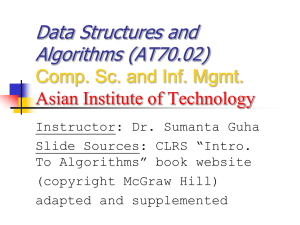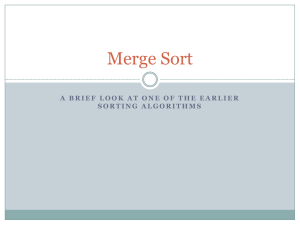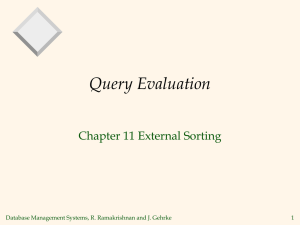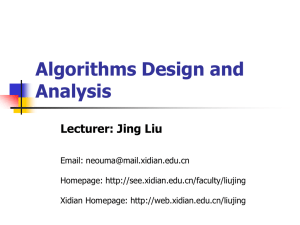Introduction of Algorithm and its Analysis
advertisement
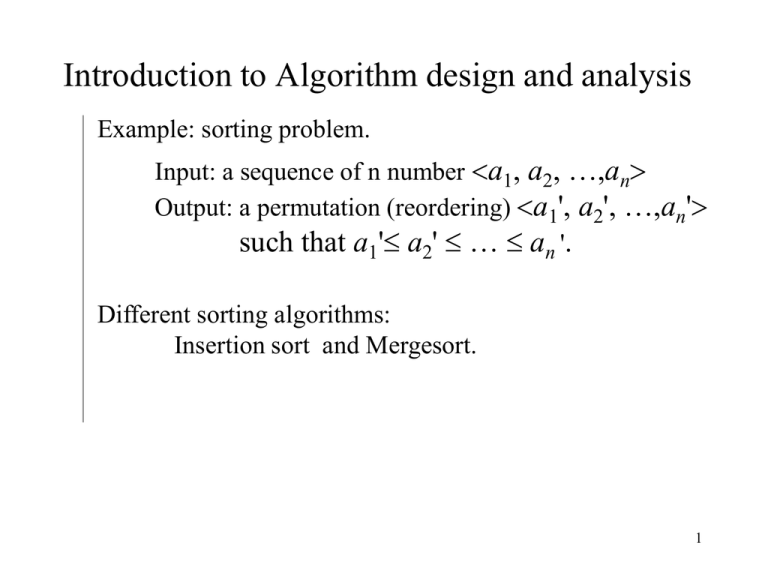
Introduction to Algorithm design and analysis
Example: sorting problem.
Input: a sequence of n number a1, a2, …,an
Output: a permutation (reordering) a1', a2', …,an'
such that a1' a2' … an '.
Different sorting algorithms:
Insertion sort and Mergesort.
1
Efficiency comparison of two algorithms
• Suppose n=106 numbers:
– Insertion sort: c1n2
– Merge sort: c2n (lg n)
–
–
–
–
–
–
Best programmer (c1=2), machine language, one billion/second computer A.
Bad programmer (c2=50), high-language, ten million/second computer B.
2 (106)2 instructions/109 instructions per second = 2000 seconds.
50 (106 lg 106) instructions/107 instructions per second 100 seconds.
Thus, merge sort on B is 20 times faster than insertion sort on A!
If sorting ten million numbers, 2.3 days VS. 20 minutes.
• Conclusions:
– Algorithms for solving the same problem can differ dramatically in their
efficiency.
– much more significant than the differences due to hardware and software.
2
Algorithm Design and Analysis
• Design an algorithm
– Prove the algorithm is correct.
• Loop invariant.
• Recursive function.
• Formal (mathematical) proof.
• Analyze the algorithm
– Time
• Worse case, best case, average case.
• For some algorithms, worst case occurs often, average case is often roughly as bad as
the worst case. So generally, worse case running time.
– Space
• Sequential and parallel algorithms
– Random-Access-Model (RAM)
– Parallel multi-processor access model: PRAM
3
Insertion Sort Algorithm (cont.)
INSERTION-SORT(A)
1. for j = 2 to length[A]
2.
do key A[j]
3.
//insert A[j] to sorted sequence A[1..j-1]
4.
i j-1
5.
while i >0 and A[i]>key
6.
do A[i+1] A[i] //move A[i] one position right
7.
i i-1
8.
A[i+1] key
4
Correctness of Insertion Sort Algorithm
• Loop invariant
– At the start of each iteration of the for loop, the
subarray A[1..j-1] contains original A[1..j-1] but in
sorted order.
• Proof:
– Initialization : j=2, A[1..j-1]=A[1..1]=A[1], sorted.
– Maintenance: each iteration maintains loop invariant.
– Termination: j=n+1, so A[1..j-1]=A[1..n] in sorted
order.
5
Analysis of Insertion Sort
INSERTION-SORT(A)
cost times
1.
for j = 2 to length[A]
c1
n
2.
do key A[j]
c2
n-1
3.
//insert A[j] to sorted sequence A[1..j-1]
0
n-1
4.
i j-1
c4
n-1
5.
while i >0 and A[i]>key
c5
j=2n tj
6.
do A[i+1] A[i]
c6
j=2n(tj –1)
7.
i i-1
c7
j=2n(tj –1)
8.
A[i+1] key
c8
n –1
(tj is the number of times the while loop test in line 5 is executed for that value of j)
The total time cost T(n) = sum of cost times in each line
=c1n + c2(n-1) + c4(n-1) + c5j=2n tj+ c6j=2n (tj-1)+ c7j=2n (tj-1)+ c8(n-1)
6
Analysis of Insertion Sort (cont.)
• Best case cost: already ordered numbers
– tj=1, and line 6 and 7 will be executed 0 times
– T(n) = c1n + c2(n-1) + c4(n-1) + c5(n-1) + c8(n-1)
=(c1 + c2 + c4 + c5 + c8)n – (c2 + c4 + c5 + c8) = cn + c‘
• Worst case cost: reverse ordered numbers
– tj=j,
– so j=2n tj = j=2n j =n(n+1)/2-1, and j=2n(tj –1) = j=2n(j –1) = n(n-1)/2,
and
– T(n) = c1n + c2(n-1) + c4(n-1) + c5(n(n+1)/2 -1) + + c6(n(n-1)/2 -1) +
c7(n(n-1)/2)+ c8(n-1) =((c5 + c6 + c7)/2)n2 +(c1 + c2 + c4 +c5/2-c6/2c7/2+c8)n-(c2 + c4 + c5 + c8) =an2+bn+c
• Average case cost: random numbers
– in average, tj = j/2. T(n) will still be in the order of n2, same as the worst case.
7
Merge Sort—divide-and-conquer
• Divide: divide the n-element sequence into
two subproblems of n/2 elements each.
• Conquer: sort the two subsequences
recursively using merge sort. If the length
of a sequence is 1, do nothing since it is
already in order.
• Combine: merge the two sorted
subsequences to produce the sorted answer.
8
Merge Sort –merge function
• Merge is the key operation in merge sort.
• Suppose the (sub)sequence(s) are stored in
the array A. moreover, A[p..q] and
A[q+1..r] are two sorted subsequences.
• MERGE(A,p,q,r) will merge the two
subsequences into sorted sequence A[p..r]
– MERGE(A,p,q,r) takes (r-p+1).
9
MERGE-SORT(A,p,r)
1. if p < r
2. then q (p+r)/2
3.
MERGE-SORT(A,p,q)
4.
MERGE-SORT(A,q+1,r)
5.
MERGE(A,p,q,r)
Call to MERGE-SORT(A,1,n) (suppose n=length(A))
10
Analysis of Divide-and-Conquer
• Described by recursive equation
• Suppose T(n) is the running time on a problem of
size n.
• T(n) = (1) if nnc
aT(n/b)+D(n)+C(n) if n> nc
Where a: number of subproblems
n/b: size of each subproblem
D(n): cost of divide operation
C(n): cost of combination operation
11
Analysis of MERGE-SORT
Divide: D(n) = (1)
Conquer: a=2,b=2, so 2T(n/2)
Combine: C(n) = (n)
T(n) = (1) if n=1
2T(n/2)+ (n) if n>1
• T(n) = c if n=1
2T(n/2)+ cn if n>1
•
•
•
•
12
Compute T(n) by Recursive Tree
• The recursive equation can be solved by recursive
tree.
• T(n) = 2T(n/2)+ cn, (See its Recursive Tree).
• lg n+1 levels, cn at each level, thus
• Total cost for merge sort is
– T(n) =cnlg n +cn = (nlg n).
– Question: best, worst, average?
• In contrast, insertion sort is
– T(n) = (n2).
13
Recursion tree of T(n)=2T(n/2)+cn
14
Order of growth
• Lower order item(s) are ignored, just keep the
highest order item.
• The constant coefficient(s) are ignored.
• The rate of growth, or the order of growth,
possesses the highest significance.
• Use (n2) to represent the worst case running time
for insertion sort.
• Typical order of growth: (1), (lg n),
(n),(n), (nlg n), (n2), (n3), (2n), (n!)
• Asymptotic notations: , O, , o, .
15
There exist positive constants c
such that there is a positive constant n0
such that …
cg(n)
There exist positive constants c1 and c2
such that there is a positive constant n0
such that …
c2g(n)
f(n)
c1g(n)
n0
f(n)
n
n0
f(n) = ( g(n))
n
f(n) = O( g(n))
There exist positive constants c
such that there is a positive constant n0
such that …
f(n)
cg(n)
n0
f(n) = ( g(n))
n
16
Prove f(n)=an2+bn+c=(n2)
• a, b, c are constants and a>0.
• Find c1, and c2 (and n0) such that
– c1n2 f(n) c2n2 for all n n0.
• It turns out: c1 =a/4, c2 =7a/4 and
– n0 = 2max(|b|/a, sqrt(|c|/a))
• Here we also can see that lower terms and
constant coefficient can be ignored.
• How about f(n)=an3+bn2+cn+d?
17
o-notation
• For a given function g(n),
– o(g(n))={f(n): for any positive constant c,there exists a
positive n0 such that 0 f(n) cg(n) for all n n0}
– Write f(n) o( g(n)), or simply f(n) = o( g(n)).
2g(n)
g(n)
1/2g(n)
f(n)
n0 n0 n0
n
f(n) = o( g(n))
18
Notes on o-notation
• O-notation may or may not be asymptotically tight
for upper bound.
– 2n2 = O(n2) is tight, but 2n = O(n2) is not tight.
• o-notition is used to denote an upper bound that is
not tight.
– 2n = o(n2), but 2n2 o(n2).
• Difference: for some positive constant c in Onotation, but all positive constants c in o-notation.
• In o-notation, f(n) becomes insignificant relative to
g(n) as n approaches infinitely: i.e.,
– lim f(n) = 0.
n g(n)
19
-notation
• For a given function g(n),
– (g(n))={f(n): for any positive constant c, there exists a
positive n0 such that 0 cg(n) f(n) for all n n0}
– Write f(n) ( g(n)), or simply f(n) = ( g(n)).
• -notation, similar to o-notation, denotes lower
bound that is not asymptotically tight.
– n2/2 = (n), but n2/2 (n2)
• f(n) = ( g(n)) if and only if g(n)=o(f(n)).
• lim f(n) =
n g(n)
20
Techniques for Algorithm Design and Analysis
• Data structure: the way to store and organize data.
– Disjoint sets
– Balanced search trees (red-black tree, AVL tree, 2-3 tree).
• Design techniques:
– divide-and-conquer, dynamic programming, prune-and-search,
laze evaluation, linear programming, …
• Analysis techniques:
– Analysis: recurrence, decision tree, adversary argument,
amortized analysis,…
21
NP-complete problem
• Hard problem:
– Most problems discussed are efficient (poly time)
– An interesting set of hard problems: NP-complete.
• Why interesting:
– Not known whether efficient algorithms exist for them.
– If exist for one, then exist for all.
– A small change may cause big change.
• Why important:
– Arise surprisingly often in real world.
– Not waste time on trying to find an efficient algorithm to get best
solution, instead find approximate or near-optimal solution.
• Example: traveling-salesman problem.
22

